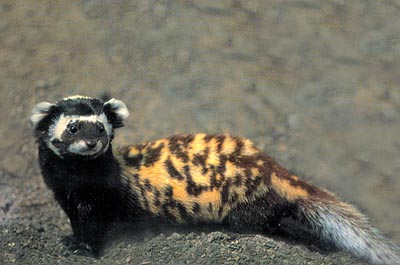Facts About Marbled polecat
The marbled polecat is a captivating small mammal belonging to the mustelid family, specifically the Ictonychinae subfamily, and it resides within the unique genus Vormela. The name "Vormela" is derived from the German word "Würmlein" meaning "little worm" while "peregusna" comes from the Ukrainian word for "polecat." These animals flourish in dry regions and grasslands, extending from southeastern Europe to western China. When threatened, marbled polecats can release a pungent secretion from their anal sacs to deter predators.
Physically, marbled polecats are highly distinctive. They possess short muzzles, large ears, short legs with long claws, and a striking coat adorned with black and white facial markings. They typically weigh between 295 and 715 grams, with females being smaller than males. Mostly active during twilight hours, they rely on their strong sense of smell due to their poor eyesight. They are predominantly solitary creatures, marking their territory and often displaying aggression when encountering one another.
Marbled polecats inhabit open deserts, rocky regions, scrub forests, and farmlands. They frequently utilize burrows made by ground squirrels or excavate their own dens. Their diet is quite diverse, including rodents, birds, reptiles, insects, and occasionally fruits. They have also been known to steal poultry and human food. The breeding season runs from March to June, with delayed implantation resulting in litters of four to eight cubs.
Regrettably, the marbled polecat is classified as vulnerable according to the IUCN Red List due to a significant decline in population caused by habitat destruction and a decrease in available prey. They are listed as endangered in Pakistan. Historically, they have been hunted for their fur, and their defensive odor can elicit strong reactions in humans.
Marbled polecats are known by various names across different regions and are easily recognized by their unique appearance and behaviors. There are several subspecies of Vormela peregusna, including alpherakyi, euxina, negans, pallidor, peregusna, and syriaca. Research on their skull morphology reveals a gradual variation from west to east, suggesting various factors influencing their evolution and diversification.

 Turkey
Turkey